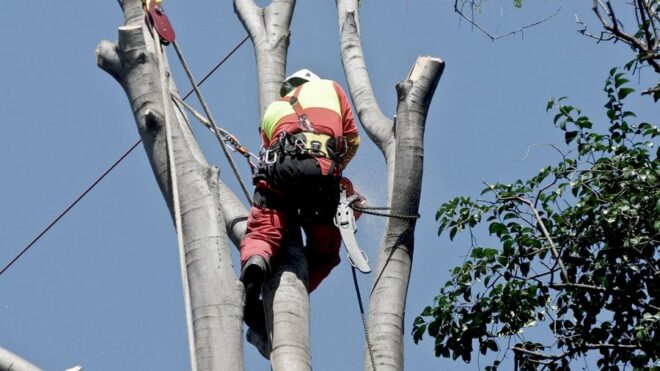Best Time to Remove Trees: A Seasonal Guide | P&D Tree Service
Wondering when it is best to remove trees from your property? Read on to find out the best times of year to tackle tree removal, trimming, and land clearing with P&D Tree Service.
Did you know that there are many situations in which a fallen tree isn’t covered under your homeowner’s insurance? This can include floods, earthquakes, disease to the tree, and more. This is why getting regular tree maintenance and inspections are so important.
Because tree trimming and removal can cost anywhere from $300 to $3,000, you may want to find the best time to remove trees. There are pros and cons to waiting, depending on the season, where you could save some money. We’ll cover all the tree removal seasons in this comprehensive guide.
This is what our experts and arborists have to say for each season.
Spring (March-May):
Spring is a season that quite a few people might think is the best time to remove trees. However, timing is of the essence when it comes to removing trees and it all comes down to why you want them gone. According to the National Arbor Day Foundation, trimming trees in the spring can be beneficial.
During spring, the tree grows new buds which can make it challenging to see the tree’s structure. Most of the deadwood would already be gone if a tree is pruned during this season. It’s also easier to evaluate the tree’s overall shape and plan for pruning or removal.
But careful evaluation and planning are required before trimming or removing trees. That is why certain species, like maple and oak trees, should not be pruned during this season. They can develop diseases if cut in the early part of the year. Sap-seeping species like maples will produce more stains that will also be difficult to clean during the spring season. This results in damage to the main structure of the species.
The season of the year also impacts the affected trees following trimming or pruning. It’s necessary to keep away from removing any excess inner wood within the structure of the tree, as pruning hardwood trees during the spring season can spark outburst growth when the temperature rises and the growth of the tree accelerates dynamically.
Summer (June-August):
While summer signifies vacations for most people, it’s also the peak growing season for trees. Trees perk up during this season, and pruning promotes sunlight and proper air circulation within the tree, ensuring a healthy, long lifespan.
During summer, the storm also brings strong winds and heavy rains that can cause branches to obscure lanes, fall on the roof, fence, or on the pathways of your house. Dead branches from precious trees and problems with tree structure can be fixed in order to prevent possible damage to persons or property.
Moreover, tree trimming is important to keep your trees healthy, encourage growth, and maintain their fullness. Don’t forget owls and other migratory bird species space within your property can also suffer if tree limbs are shelter places removed at night in the summertime. These spaces are critical for native species as temperatures continue to soar into record numbers.
Remember, birds are your friends, acting as the most effective form of pest control against pesky mosquitoes and flies.
Fall (September-November):
The fall season is one of the best to tackle trimming or removal. As the growth of the tree slows down during this time, pruning can promote the harvesting of fresh wood or commercial material. Limbs and branches naturally begin to show decay symptoms by falling off the tree structure themselves. This is also one way to determine if a tree is potentially dead, and then remove it when certain indicators evolve as well.
In the fall season, particularly after a storm, it is common for multiple trees to become hazardous. It is crucial to thoroughly evaluate your tree’s condition and remove any defective branches or limbs. Trees that display noticeable defects can present a significant risk and should be dealt with promptly. The fall weather is ideal for emergency jobs, as the ground is drier due to falling leaves.
Moreover, workers can efficiently complete tasks as the temperature during the fall is typically conducive to reasonable cutoffs.
Winter (December-February):
Winter-dormant trees can be removed throughout the year, making winter another optimal tree removal season. The colder temperatures around the entire system of the tree during winter emphasize less stress and fewer negative effects. At P&D Tree Service, we prefer to remove trees in the dormant season.
Roads occupied by people and pets during this time can be extremely dangerous and vulnerable trees can be freed to occupy spaces put in a facade of safety and protection during winter.
As winter removal has less of a negative impact on most species, it makes structural analysis a statistically valid year-round proposition. Especially in areas where snow, strong winds, and heavy rains visit throughout November and December. During preparation for all types of maintenance that are done in spring and summer, removing your winter residence trees and limbs can make summertime hosting patio decoration a lot more stress-free.
Is the Best Time to Remove Trees Now?
Tree removal is worth considering for safety and foundation concerns, disease, or pest infestation. While tree removal can take place throughout the year, the process and considerations may differ depending on the season. Ultimately, the best time to remove trees on your property will have to come down to the opinion of an arborist.
Don’t make your decision based on general landscaping opinions. Contact us today to learn what your best options are for tree care and removal.

